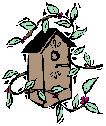Wherever you live, work, or play, there is something you or a group can do to help a habitat. Think about your: Home, School, Neighborhood, Business, Park, or Farm.
For a free color booklet on Backyard Conservation call toll free: 1-888-526-3227
Do you have a yard? A balcony? A strip of grass between the sidewalk and your building? Any open area can become a better habitat!
Does your workplace or school have some unused property that is costing money to keep mowed? Or is there a small woods or fence row that could be improved for wildlife?
Is there a local park needing bird houses or a habitat with
a non-native plant problem?
What Can You
Do?
 What do
you want to attract? This will tell you what kind of food to
provide.
What do
you want to attract? This will tell you what kind of food to
provide.
Butterflies look for flower nectar. In a small, sunny spot, prairie flowers and make a great butterfly garden, and provide habitat for lots of helpful insects. In a shady spot, woodland flowers can thrive.
Birds are attracted by berries, seeds, insects, and fat (suet). Some eat just one type of food, others eat many varieties. Some will come to feeders, others will be attracted by berries, blossoms, and flower seeds. Learn your backyard birds and what they eat - then you can put out the right feed, feeders, flowers, shrubs and trees.
Squirrels like corn and seeds. Opossum,
raccoons, and deer may wander by also to eat whatever
falls on the ground. Squirrels and raccoons can climb a pole, eat
a lot of food, scare away birds, and destroy bird feeders - but a
stove pipe under a feeder will keep them off.
 A birdbath, small pond, or fountain is all you need. (Caution: If
small children are around, even a birdbath could be a drowning
hazard.) Garden stores sell small water pumps to make a waterfall
- birds are attracted to the sound of dripping water! You can
also buy a small pond kit, or sink an old tub in the yard and put
rocks around for a natural look.
A birdbath, small pond, or fountain is all you need. (Caution: If
small children are around, even a birdbath could be a drowning
hazard.) Garden stores sell small water pumps to make a waterfall
- birds are attracted to the sound of dripping water! You can
also buy a small pond kit, or sink an old tub in the yard and put
rocks around for a natural look.
Whatever kind of water source you provide, be sure to clean it
regularly!
Animals need places to get out of the wind or to feel safe
from predators. Evergreens, shrubs, prairie grasses, thickets,
rock or brush piles, and wood shelters are all used by different
animals. The more types of shelters you provide, the greater
diversity of wildlife you will attract.
Bird and bat houses are needed because people keep cutting down old and hollow trees. Many species of birds make their nest in tree cavities. Woodpeckers, bluebirds, wrens, chickadees, kestrels, some owls, and many other types of birds use nest boxes that you can make or buy.
Cats Indoors! House cats that are allowed to roam the neighborhood can have a devastating effect on certain species of birds which nest on the ground or low in thickets and shrubs. They also can grab chickadees, warblers, woodpeckers, doves, and many other types of birds that are attracted to yards for food or water, as well as chipmunks, ground squirrels, shrews, wolves, garter snakes, and other small creatures. Responsible pet owners do not let their cats out unsupervised - in fact, some communities prohibit cats to roam free.
|| Wildlife || Farm Photos || Barn Photos || On US 12 ||
|| Agricultural Links ||
